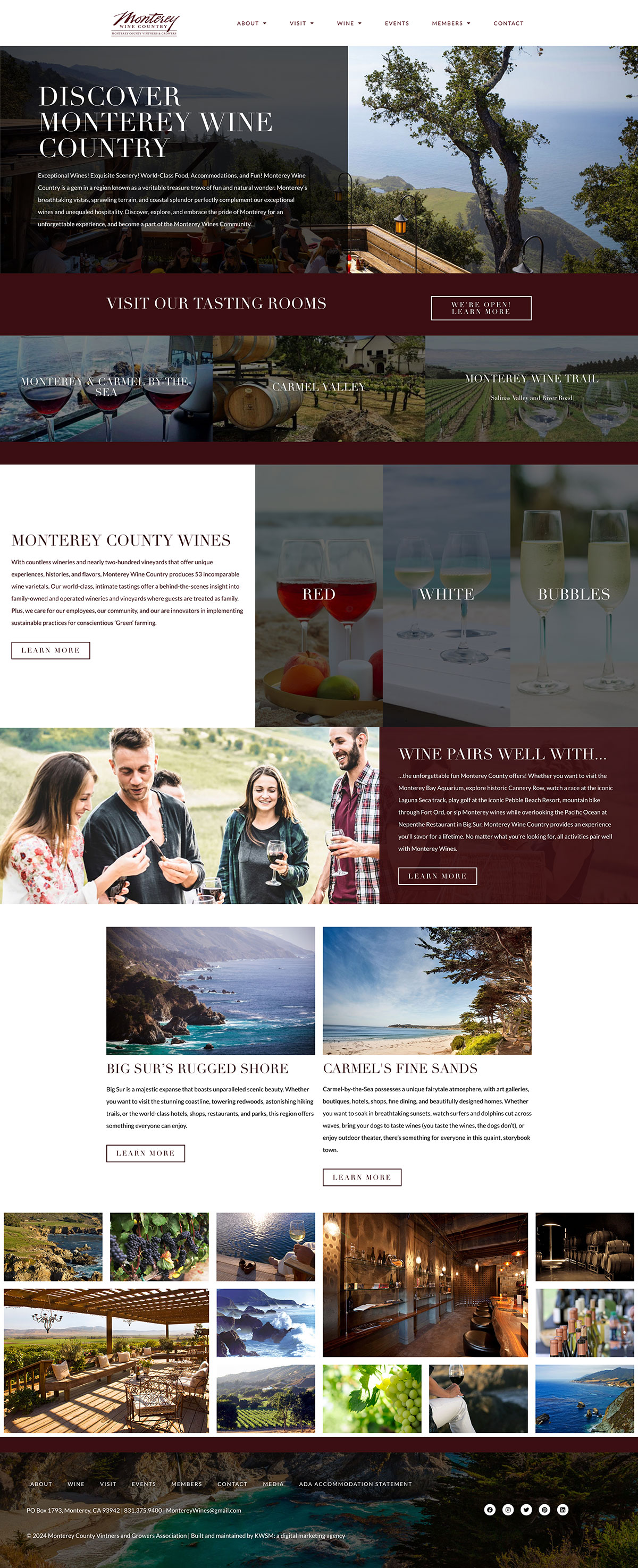
CRO, or Conversion Rate Optimization, is the process of optimizing the pages of your website to turn more of your visitors into clients or customers. These are the assessments, analyses and enhancements throughout your website’s user experience to increase the conversion percentage of your visitors. Ongoing CRO can drive the growth of your business online.

CRO doesn’t mean increasing traffic through paid ads or Search Engine Optimization (SEO). SEO and Ads are important and will help increase conversions simply by opening up the funnel on the volume of visitors to your website. However, a page or site that isn’t optimized conversions will always have a lower conversion rate than one that is optimized.
As a website and SEO specialist, I work with our team to find places where websites are leaking conversions and optimize to increase the percentage of web visitors into conversion. There are many ways to work towards this, but I will focus on core principles we use here at KWSM to help our clients succeed.
Key Fundamentals of a Conversion-Optimized Page
For the best opportunity to convert, each page needs to answer the following questions for the visitors; these questions should point to the business’s main goal. Ideally, the answers to these questions are in the above-the-fold section.
“We start with the digital marketing strategy and the tactics that help support the business goals, but marketing is never “set it, and forget it. We are optimizing on two fronts – we are focused on CRO for the website experience that you welcome new visitors to and we are fine-tuning our audiences, messaging, and images to help drive them to your website.”
– Jeff Soto, KWSM VP of Strategy and Client Relations
Questions Every Page Needs to Answers for CRO
- Who is this product or service for? (Are they the right audience?)
- How are you different? (Why work with you over someone else?)
- Why should they trust you? (Do you have good, credible pieces?)
- Why would it benefit them? (If they don’t use your product or service, would they be worse off?)
- How do they take action? (Are there clear Call to Action buttons?)
Note: this needs to point to the main business goal. For example, we could give them the ability to take action by learning about the team, but a free consultation would be more aligned with their business goals.
The 3 Cs of CRO and User Experience
At KWSM, we created these 3 Cs to guide our CRO and User Experience (UX) process. This gives us and our clients guiding points for every web page that we build and optimize. CRO is essentially bringing the website visitor closer and closer to the action that will help the business achieve its goals.
Related Article: How User Experience & Web Design Affects Website Performance
The 3 Cs of CRO and UX below will help us understand the core principles of CRO. See a visual example of these elements on our Digital Marketing Strategy page.
Confirmation
Each page you want to convert must confirm that your company offers what your website visitors need and that you offer it where they need it. The page should show that the product or service is what a web visitor needs, and that it is for their audience and their community. Community could mean their region, for example, their city or group they belong to, for example, recreational baseball players.
We want to enable website visitors to self-qualify themselves. Unless a user thinks, “Hey, this is for me,” they are unlikely to convert. They should be able to confirm at a basic level by just reading the main header on the page (the H1). As they continue down the page, they should become more and more certain that this “offer” is for them. The “offer” is whatever is most important to provide them to convert.
One way to encourage this is by countering any objections your audience is likely to have. This is called “objections handling”. If you aren’t sure what common objections people may have, talk with your sales team to see what common questions and objections they hear. Having this reassurance content around the area of conversion (i.e., the contact form or add to cart button) helps users move through the conversion process. Strategically placed copy on a website can help nudge them along the process.
These confirmation tactics also help with SEO since they demonstrate higher relevance to the targeted audience and keyword, which is what Google is looking for as well.
Related Article: How To Rank First On Google
Key Aspects of Confirmation
- What you do or sell is immediately apparent, and more details are revealed as they scroll down the page
- Show how the service/product transforms their life for the better (and solves their problem in the process)
- Speak to the audience in their language
- Speak to the location(s) served (in the copy and/or embed a map)
- Objection handling
- Include FAQs that address common objections, not just common questions.
- Bold key ideas in the copy
Credibility
The page must show why you are credible to provide your offer. Credibility pieces prove that the company is experienced and qualified to provide whatever service or product your company offers. People don’t want to be the first person to trust your business. By proving others have worked with your business and benefited from the experience, you make the conversion more likely.
Credibility can be established through elements like case studies, statistics, testimonials, and third-party reviews. Google Reviews and review badges are great because users attach higher credibility to respected outside sources. Choose reviews that address common objections and key benefits.
Related Article: Are Google Reviews Important?
Key Elements of Credibility
- Google review feed or badge
- E-commerce reviews
- Testimonials
- Case studies
- Statistics, for example, how many clients you have served
- Partner logos
- Reviews
Clear Instructions
Once they confirm that this page offers what they are looking for and determine that the business is credible they will need clear instructions to take action. This is how your website visitor can engage with your company. The lower the friction, the better. This means shorter forms, an enticing, clear call-to-action (CTA) and/or an easier checkout process.
Having a process timeline can also help users understand what to expect once they act. If they want the result at the end of the process, then if you connect the act of converting to working towards the end result, they are more likely to start the process and, therefore, convert.
To come up with an enticing CTA image, use two to five words that describe the step they are taking by converting. For example, “Get Your Strategy Quote” is better than “Learn More”. Talk to current customers about what persuaded them to act, and use their language as a CTA if it’s compelling.
Related Article: Using Story To Grow Sales
Key Elements of Clear Instructions
- A short form with only the necessary fields required
- Enticing CTA copy
- Offer significant value that others aren’t offering on the front end. This gets users in the door with incredible value. Even if you lose money upfront with discounts, you will still profit over time since the value you provide turns visitors into returning customers.
- The right type of CTA—e.g., a phone call might convert better for certain audiences than a form
- Where possible, offer something of value with a transitional CTA (e.g., a downloadable or mailing list)
- This allows you to nurture them into a lead over time if they aren’t ready to convert right away.
- An easy checkout process
- Objection handling near the call-of-action (CTA)
- A 3-step process timeline of what happens once they convert
“One thing we see quite a lot on websites is that companies will skip over the confirmation and go straight to providing credibility (proof) that they’re the best at what they make or do. Meanwhile, multiple visitors have bounced because they didn’t realize they were even in the right place! This usually happens when companies don’t make what they do or what they offer to their target audiences explicitly clear on their websites. While there will always be some overlap between confirmation and credibility, both are crucial to keeping users on your site. Then, clear instructions must follow, or else those potential clients and customers will never convert.”
– Julia Chanterrwyn, UX Specialist
The Process of Conversion Rate Optimization
To optimize your pages to get a better conversation rate, you will want your pages to incorporate the 3 Cs. However, you will want to test to see which elements resonate best with your audience. We use tools like Google Analytics 4 and Hotjar to help us analyze how these elements are performing and tweak them over time to steadily increase conversions on the web pages. Occasionally, a change won’t work well, so we will revert and try something different. These outcomes are expected, but over time, by testing, analyzing, and implementing new changes, we will see more conversions. This is the process of CRO.
Conversion and User Experience optimization is an ongoing process, so we must keep working to make the pages better. This requires revisiting tracking regularly to ensure that the page is continually being optimized.
If you would like us to use this process to help turn more of your site visitors into leads or sales, fill out the form below. We will craft a specific strategy to turn more of your traffic into conversions. If you’d like a free web audit of your site, request an audit here.










